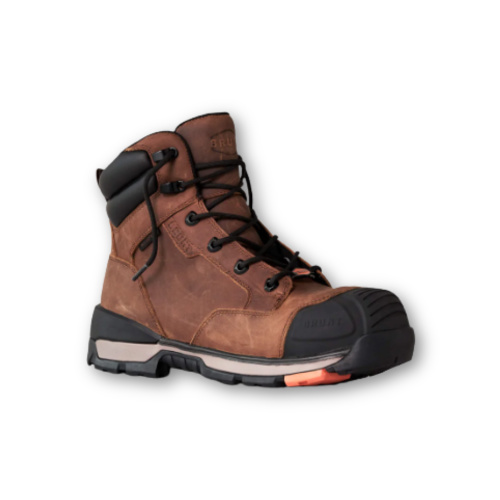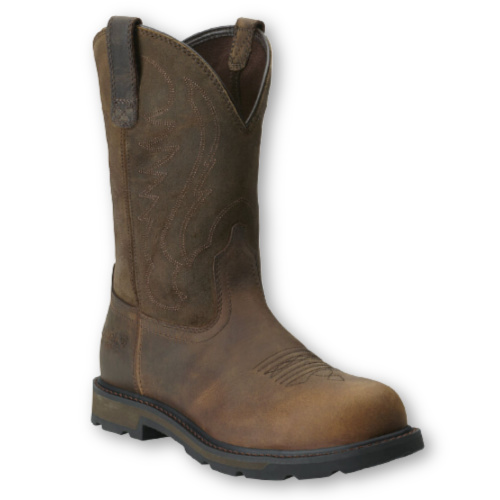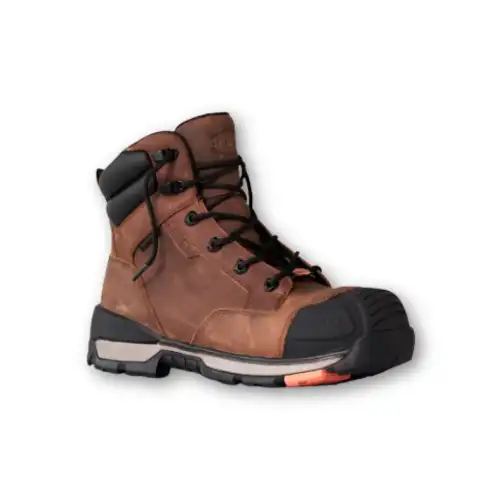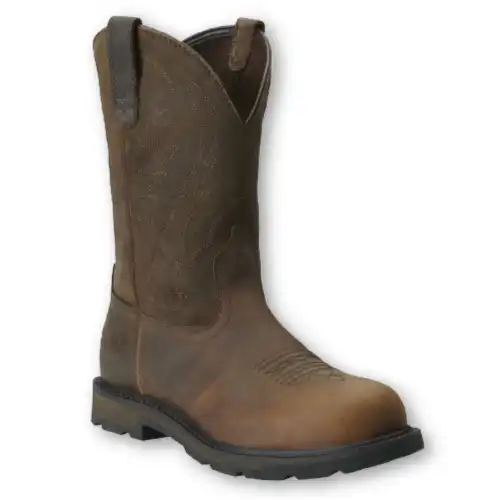Working long days on the job and can’t figure out if you should go with steel toe or composite toe boots? Overall, I recommend composite toe; however that isn’t always the case.
In this article, I’ll give a complete breakdown of each boot so you can decide which is best for you and your unique situation.
Table of Contents
Composite Toe vs Steel Toe Boots Overview

|

|
|
|---|---|---|
| Composite Toe | Steel Toe | |
| Toe Material | Fiberglass, Kevlar, Carbon Fiber | Steel |
| Average Weight | 1.75-4 pounds | 2-5 pounds |
| Durability | Weakens after one accident | Holds up after one accident |
| Shop Our Top Pick | Shop Our Top Pick |
What Is a Composite Toe Boot?
Composite toe boots are work boots that feature a composite safety toe cap. “Composite” means various elements.
The protective part of the boot contains many materials, like carbon fiber, Kevlar, fiberglass, and even plastic. They’re designed to protect your toes from impact and compression.
The upper part of a composite boot helps protect your foot from sharp edges and hot surfaces. It also helps protect you from chemicals, which can cause burns on your skin.
What’s more, composite toe boots help provide protection from electrical hazards. In fact, they’re sometimes referred to as an electrical hazard boot.
Composite toe boots stand out from steel toe boots because they’re more lightweight and more comfortable. Some composite toe boots are about 30% lighter than steel toe boots.
They’re also better for working in cold or hot temperatures. This is because composite toe boots don’t contain any metals, so they don’t transfer temperatures from the environment to your feet very well. The materials used in composite toes (like fiberglass and Kevlar) contain very little temperature-transmitting properties.
Working with live wires? Composite toe boots can also safely handle direct contact with live electrical circuits. Because there’s no metal in composite toes, there’s no chance electricity can travel through the material to your foot.
Granted, OSHA doesn’t generally consider steel toe boots to be hazardous in electrical environments either, as long as the metal toe isn’t touching your foot and isn’t exposed on the outside of the shoe.
If you’re anything like me, you’d rather not chance it.
We all know accidents are bound to happen on a worksite. The last thing you want to do is unknowingly expose your steel when you’re around electricity.
On the downside, composite toe boots have been shown to weaken after one accident, even though there’s no visible damage. In other words, if a concrete block falls on your composite safety toe, get a new pair. Otherwise, your toes might not be so lucky next time.
Waterproof, safety toe, meets electrical hazard ratings and is slip resistant on oily concrete---what else do you need? The Brunt Perkins is a solid comp toe boot that's comfortable for long days on your feet.
Types of Composite Toes
Because composite toes are created from different materials, there are several types. Three of the most popular include:
- Fiberglass
Fiberglass is the least expensive option and provides the least amount of protection. It’s good for people like airport employees, who work around things like suitcases and golf carts and are not in industrial areas.
- Kevlar
Kevlar is the most expensive option but offers the highest level of protection. This is a great option if you work in more dangerous areas surrounded by heavy machinery and crushing hazards.
- Carbon Fiber
Carbon fiber falls in between fiberglass and Kevlar as far as pricing and protection. It’s good if you’re more price-sensitive and work in environments with moderately dangerous impact and compression risks (see this guide to discover eight other workboot options under $100).
Popular Uses
Composite toe boots are commonly used in:
- Workplaces that require a safety toe but also require people to be on their feet all day (like warehouses). This is because composite toes are lightweight and allow for maximum flexibility.
- Construction and industrial sites where heavy machines and tools are being used all day long.
- Emergency zones. Firefighters and other first responders can run through hot zones without getting burned.
- Chemical zones. For example, composites are used by military personnel who need protection against chemical warfare agents (CWAs).
What I Like
- Composite toe boots are lighter and more comfortable to wear for hours at a time than steel toe boots.
- They don’t transmit heat or cold very well, so you can more comfortably wear them in extreme temperatures.
- They can’t conduct electricity, so they’re the safest boot to wear around electrical hazards.
- They won’t set off metal detectors, so they’re perfect for working in high-security areas like airports.
What I Don’t Like
- Composite toe boots can’t withstand as much repeated impact or compression as steel toe boots.
- Depending on the quality you need, they can be more expensive and harder to find than similarly rated steel toe boots.
Waterproof, safety toe, meets electrical hazard ratings and is slip resistant on oily concrete—what else do you need? The Brunt Perkins is a solid comp toe boot that’s comfortable for long days on your feet.
What Is a Steel Toe Boot?
The ASTM F2413-18 standard (don’t worry, I’ll explain what all those letters and numbers mean in a little bit) defines a steel toe boot as one that has a protective plate made from steel, a thermoplastic material, or an alloy. The design must also include an upper that is made from leather or synthetic leather.
The protective plate must be at least 0.75 inches thick and withstand a minimum of 200 joules (j) when tested against impact energy. The protective plate must also have a hardness between HRC 40 and HRC 65.
In addition, the steel toe boot must have at least 3mm of insulation around the toes, plus additional insulation around the heels and ball of the foot. It should also have a slip-resistant outsole with good traction in wet conditions.
If something falls or rolls onto your foot, the steel plate will absorb some of the shock before it reaches you. This helps prevent serious injuries like broken toes and crushed metatarsals (the bones between your toes).
A steel toe boot’s upper part helps protect your foot from sharp edges, whether from something like a stray piece of metal or even a saw. Like composite boots, they help protect your upper foot from chemicals that shouldn’t touch your skin.
Steel toe boots stand out from composite because they’re more durable. Unlike composites, steel toes have been shown to withstand more than one accident before weakening.
The Groundbreaker has a lot of cushion in the insole, so it's comfortable for long work days. But the leather is tough and the steel toe can take a beating when it needs to.
Popular Uses
Steel toe boots are commonly used by people who work in:
- Construction sites where heavy machines and tools are used all day.
- Law enforcement, where people are trying to hurt you.
- Industrial sites, where objects are hoisted in the air above you and heavy machinery is operating.
- Factories, where you’re required to pick up boxes and other heavy objects that could fall onto your feet.
- Environments where sharp objects, from broken glass to saws to stray pieces of metal, can cut through regular shoes like butter.
What I Like
- Steel toe boots are more durable because they can withstand repeated impact and compression before weakening.
- You don’t have to replace them as often as composite toes because they last longer.
- They’re readily available and can be less expensive than similarly rated composite toes. .
What I Don’t Like
- Steel toe boots aren’t as lightweight or comfortable as composite toes.
- They transmit heat and cold, so they’re not great for wearing in uncomfortable temperatures.
The Groundbreaker has a lot of cushion in the insole, so it’s comfortable for long work days. But the leather is tough and the steel toe can take a beating when it needs to.
Safety Ratings (Decoded)
Each type of composite and steel toe has a different safety rating. Make sure the boots you’re considering have the safety ratings your employer requires.
However, checking the safety rating on the workboot you’re considering can make you go cross-eyed with its mumble-jumble of words and letters.
Here’s a cheat sheet you can use to figure out your boot’s safety rating:
ASTM F2413-11 M I/75 C/75 EH means:
- F2413 identifies that this boot follows the ASTM Standard
- The “11” identifies this particular standard was created in 2011
- M (Male) or F (Female)
- I/75 (Impact safety-toe protection) and C/75 (Compression safety-toe protection)
- I/75 C/75 means your toes will be safe from an impact of up to 75 foot-pounds and compressive loads up to 2,500 pounds
- EH – The last letters identify a specific protection. EH stands for Electrical Shock Resistant Protection
Difference Between Composite Toe and Steel Toe Boots
OSHA-Approved
Both composite and steel toe boots are OSHA-approved.
However, each employer requires different specifications depending on the specific environment. Just because a composite or steel toe is OSHA-approved for one jobsite doesn’t mean it’s approved for all.
There isn’t a “winner” here. You just need to be sure to ask your employer what their particular requirements are, so you can keep your toes safe and sound every day.
Weight/Comfort
The average weight of a composite toe boot is around 1.75-4 pounds, while a steel toe boot can weigh 2-5 pounds.
Composite toes won’t make your feet feel like they’re carrying around bricks all day and they breathe easier. The downside is they aren’t as sturdy as steel toes and can’t hold up as well when it comes to heavy-duty work environments.
If you don’t think you’ll have objects dropping or rolling onto your foot except in very rare, isolated cases, composite toes are the way to go.
Durability
While steel toe and composite toe can withstand the same weight (if their safety ratings are the same), composite toes aren’t as durable when it comes to repeated impact or compression.
They’ve been shown to weaken after being exposed to impact or compression, even though you can’t see any outward damage. It’s best to replace any workboot—steel or composite—after something drops or rolls onto it, but steel does hold up better.
Temperature
Composite toes don’t transfer temperatures very well, which is great. That means your feet won’t get as hot (or cold) when wearing them because they’re protected from the outside temps. Unlike steel toes, which can carry the heat or cold straight to your feet.
If you work outside in all kinds of weather or inside a hot industrial area, you’ll want to strap on a pair of composite toe boots.
The Better Boot for the Job
At the end of the day, composite toe boots kick steel toes to the curb in many areas.
- Comfort in heat or cold. Composite toes don’t transmit much heat or cold, which is fantastic when you’re working in extreme temps and want your feet to stay cooler or warmer.
- Lightweight. You won’t be dragging your feet because you won’t have the extra weight that steel toes pack on.
- Zero electrical conductivity. No matter what, the materials in composite boots won’t conduct dangerous electricity levels from the ground to your body.
Steel Toe vs Composite Toe: Which is Best for You?
Use composite toe boots if:
- You’re on your feet for hours at a time and want something lightweight
- You don’t have to pick up large, heavy objects very often (or be around while they’re hoisted in the air)
- You work in more extreme temperatures and don’t want your feet to get burning hot or freezing cold
- You’re around electrical hazards and want to ensure your shoes can never conduct electricity
Use steel toe boots if:
- You’re constantly around heavy machinery that could roll onto your foot and crush it
- You lift heavy objects (or are around when they get hoisted in the air) that could drop onto your foot and do some serious damage
- You’re price-sensitive and want a safe boot that’s easier to find
If you have the choice, I say go with the composite toe. They supply comfort and insulation you won’t get with steel toe boots.
FAQs
How do you break in composite toe boots?
Walk around your house and yard for 15-20 minutes a day. This will help stretch and loosen your composite toe boots. Wear thick socks while you’re walking, as the extra materials will stretch out the boot. Also, bend the midsole of your boot back and forth and step on the heel to relax stiff areas.
Is soft toe the same as composite toe?
Soft toes are not the same as composite toes. They’re designed strictly for comfort, not to protect your foot from impact or compression. The toe of a soft toe boot is created from the same material as the upper sole, such as leather or nylon.
What is the lightest safety toe material?
Carbon nanofiber is the lightest safety toe material. It can weigh up to 50% less than steel and 40% less than other composite materials. If you can’t find a carbon nanofiber safety toe cap, carbon is the next lightest option at only .22-.50 pounds.


Join the Discussion